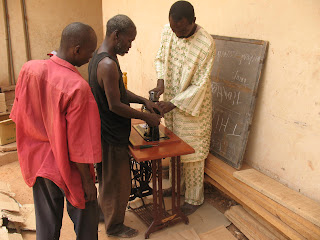"Salif Keita is an internationally recognized afro-pop singer-songwriter from Mali. He is unique not only because of his reputation as the Golden Voice of Africa, but because he is an albino living in Mali, and a direct descendant of the founder of the Mali Empire, Sundiata Keita. This royal heritage meant that he should never have become a singer, which was deemed to be a griot’s role.
Because of his albinism, he was outcast by his family and ostracized by the community, as they deemed it a sign of bad luck. He left his hometown of Djoliba for Bamako in 1967, where he joined the government sponsored Super Rail Band de Bamako. In 1973 Keita joined the group, Les Ambassadeurs. Keita and Les Ambassadeurs fled political unrest in Mali during the mid-1970s for Abidjan, Côte d'Ivoire and subsequently changed the groups name to Les Ambassadeurs Internationales. The reputation of Les Ambassadeurs Internationales rose to the international level in the 1970s and in 1977 Keita received a National Order award from the president of Guinea, Sékou Touré. Keita moved to Paris in 1984 to reach a larger audience. His music combines traditional West African music styles with influences from both Europe and the Americas, while maintaining an overall Islamic style. Keita found success in Europe as one of the African stars of world music. After much success in Europe, he returned to Mali in 2000 to live and record music."
Despite being an awesome musician and in everyone's top three favorite artist category here, Salif has a bad reputation for actually showing up to his shows. He'll make engagements in Bamako and the venue will charge an entrance fee, but he'll never come. Or if he comes, he'll play for 15 minutes and then leave. Needless to say, when a country-wide tour was announced, I was a little skeptical. It was announced that he would be in Mopti the 15th of June so Beth and Dan and I decided to go. The show started at 9. He didn't come until 11. After sitting around for awhile we got up to dance, take photos and do some video recording. Here is one recording, from stage level, and some awesome photos. Enjoy:
 The yellow light shining wasn't the best, but here's Salif!
The yellow light shining wasn't the best, but here's Salif!
 Again, Salif jamming for his crowd.
Again, Salif jamming for his crowd.
 My favorite photo! I was standing infront of the stage with everyone and the flag in the background with a fan clapping just happened all at the right time.
My favorite photo! I was standing infront of the stage with everyone and the flag in the background with a fan clapping just happened all at the right time.
But, just when I was ready to throw in the towel and go home, this guy walked up to me. He asked me if I wanted to go dance with Salif Keita on stage. I figured he was joking and that I was just going to go dance with him, but I said yes and off we went toward the stage. Despite having a skirt on, he and his friend each grabbed a leg and hoisted me on stage. Salif's backup singers helped me up and the next thing I knew, I was on stage with Salif Keita!!! I didn't know what to do, so I walked over to him and tapped him on the shoulder and when he turned around and saw me, he gave me a hug! Here's the really blurry evidence of the hug, as taken by Dan:

In the center of the photo is me with Salif Keita. I'm on the left.
After we hugged, his band started playing music and we danced a little infront of the audience where people were taking our photos and this guy on stage was videotaping the whole thing. Then I went over to his backup singers and we danced a little too:

Shortly after this photo was taken, a security guard tapped me on the shoulder and directed me off stage. I was super excited! The best part is that the next day, I ran into all of these people in Sevare that I know who were like, "Hey, I saw you last night and took a photo of you with my cell phone!" So, I'm hoping to get a clearer shot, but if not at least this blurry evidence is there.
My fame was short lived, but it was an awesome night.

















